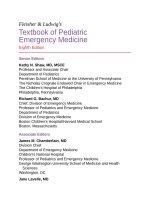Pediatric emergency medicine trisk 1830 1830
Bạn đang xem bản rút gọn của tài liệu. Xem và tải ngay bản đầy đủ của tài liệu tại đây (99.7 KB, 1 trang )
RMSF is caused by Rickettsia rickettsii transmitted by the bite of a tick (see
Chapter 66 Rash: Bacterial and Fungal Infections/Rash: Maculopapular ).
Although initially confined to the Rocky Mountain States (hence, its name),
confirmed cases have been reported from all parts of the United States with
varying tick vectors. The primary determinants in patient outcome are early
diagnosis and treatment. The best outcomes are associated with the initiation of
doxycycline therapy by day five of illness.
The rash of RMSF begins on the third or fourth day of a febrile illness as a
morbilliform eruption on the extremities, most commonly the wrists and ankles.
Over the next 2 days, the rash becomes generalized by spreading centrally to
involve the back, chest, and abdomen. Initially, the rash consists of erythematous
macules that blanch on pressure; they then become more confluent and purpuric.
Notably, the hemorrhagic lesions predominate in the peripheral distribution,
involving the palms of the hands and the soles of the feet. The severity of the rash
is proportional to the severity of the disease.
All patients with RMSF have some degree of vasculitis that is the basis for
many of the associated systemic symptoms. An overall toxic appearance is
common. Systemic signs and symptoms include fever, headache, myalgia,
conjunctivitis, vomiting, seizures, myocarditis, heart failure, shock; periorbital,
facial, or peripheral edema; and disseminated intravascular coagulation or
purpura fulminans.
Diagnosis is best made by polymerase chain reaction (PCR) testing.
Thrombocytopenia, hyponatremia, and increased aminotransferases usually
develop as the disease process progresses.
Doxycycline is the drug of choice for therapy in patients of all ages at a dose of
4 mg/kg/day in two divided doses (maximum of 100 mg two times a day),
intravenously or orally.
Ehrlichiosis
Ehrlichiosis is most common during the warmer months when ticks are most
prevalent. Nomenclature has undergone multiple changes. Currently, disease in
the United States is due to three distinct obligate intracellular bacteria: Ehrlichia
chaffeensis (human monocytic ehrlichiosis or HME), Anaplasma
phagocytophilum agent (human granulocytic anaplasmosis or HGA), or Ehrlichia
ewingii (E. ewingii ehrlichiosis). Infections with any of these bacteria cause an
illness very similar to RMSF. Rash is a less consistent feature of ehrlichiosis but
when present may be macular, morbilliform, or petechial and is more commonly
seen in pediatric patients infected with E. chaffeensis. Unlike RMSF, rash may









